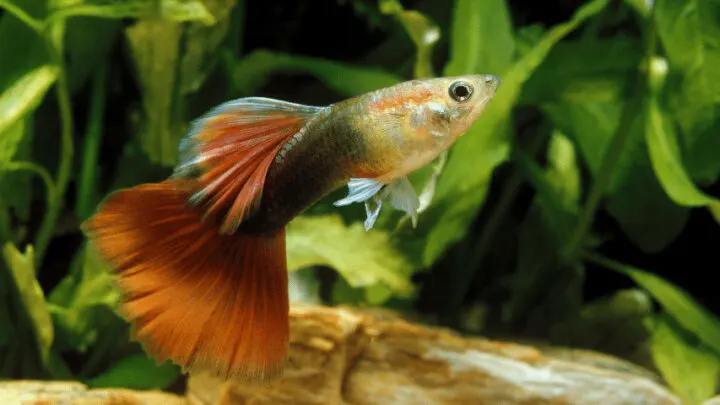Guppies are one of the most popular freshwater aquarium fish and love plants.
Apart from stimulating their natural habitat, plants help clean and oxygenate the water.
Also, mossy plants are required for guppy fry to hide from adult guppies until they have grown.
So, it is a requirement to have plants in a guppy tank.
Choosing the right plants for your guppies is important for their environment and proper care.
For this reason, we have enlisted 20 plants that are best for guppies and can also help decorate your tank.
20 Best Plants for Guppies
- Java Moss
- Flame Moss
- Christmas Moss
- Anacharis Elodea Densa
- Water Sprite
- Water Wisteria
- Java Fern
- Anubias Nana
- Guppy Grass
- Green Foxtail
- Chain Sword
- Hornwort
- Duckweed
- Red Root Floater
- Salvinia Natans
- Moss Balls
- Water Lettuce
- Amazon Sword
- Moneywort
- Cryptocoryne
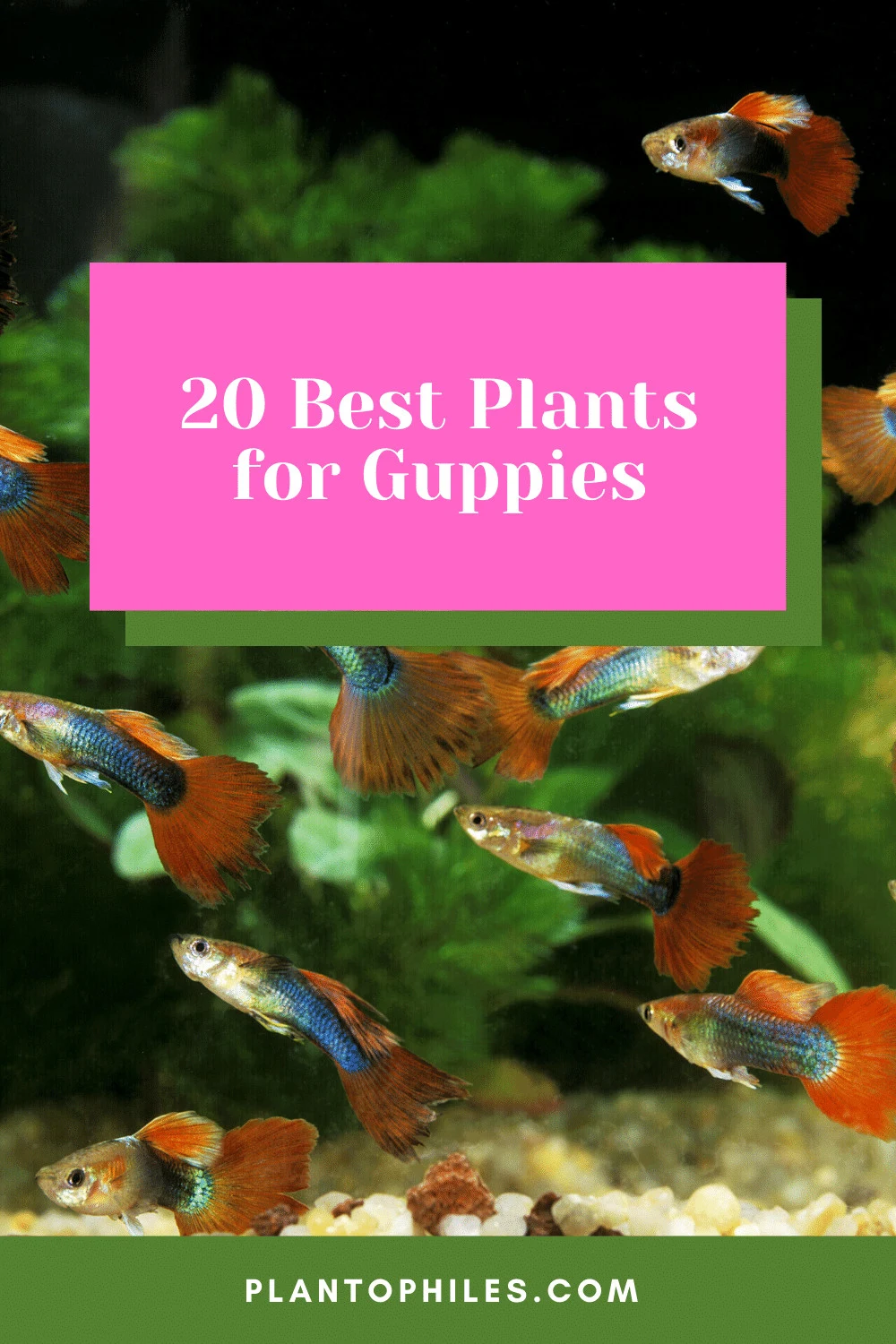
Plants for Guppies – 20 Best
1. Java Moss
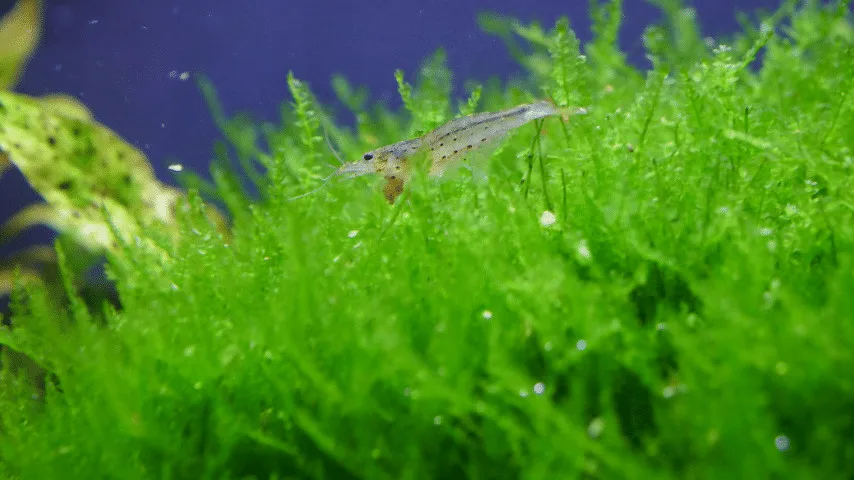
Java Moss is a fast-growing, bright green leafy plant that can survive under various conditions.
It does not require much care and is best if your guppies are constantly breeding because it provides dense hiding spaces for baby guppies.
The binomial nomenclature of Java Moss includes:
- Scientific name: Taxiphyllum barbieri
- Family: Hypnaceae
- Temperature: 60–80°F (15–27°C)
- Soil: A special substrate or soil is not particularly required because of the plant’s lightweight, making it easier to attach to any surface.
- pH: 5.0-8.0
- Environment: Requires moderately warm water with low to medium lighting for approximately 8-10 hours a day.
- Humidity: 80% to 100%
2. Flame Moss
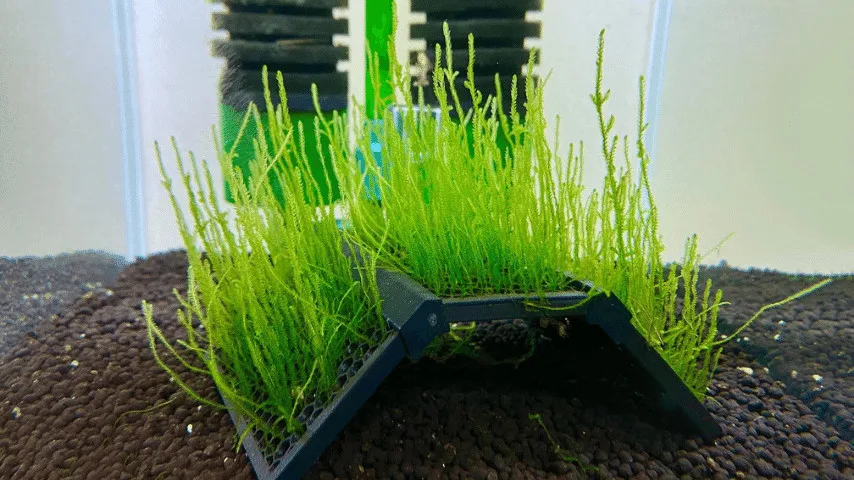
Flame Moss is a unique species of creeping moss with dark green leaves that look like flames.
It grows horizontally and, like java moss, is also a good plant for hiding spaces because of its dense bushes.
It is low maintenance and medium pace of growth.
The binomial nomenclature of Flame Moss includes:
- Scientific name: Taxiphyllum sp.
- Family: Hypnaceae
- Temperature: 68-83°F (20-28°C)
- Soil: They don’t need a specific substrate or hardscape.
- pH: 6.0-8.0
- Environment: Requires low light.
- Humidity: 80% to 100%
3. Christmas Moss
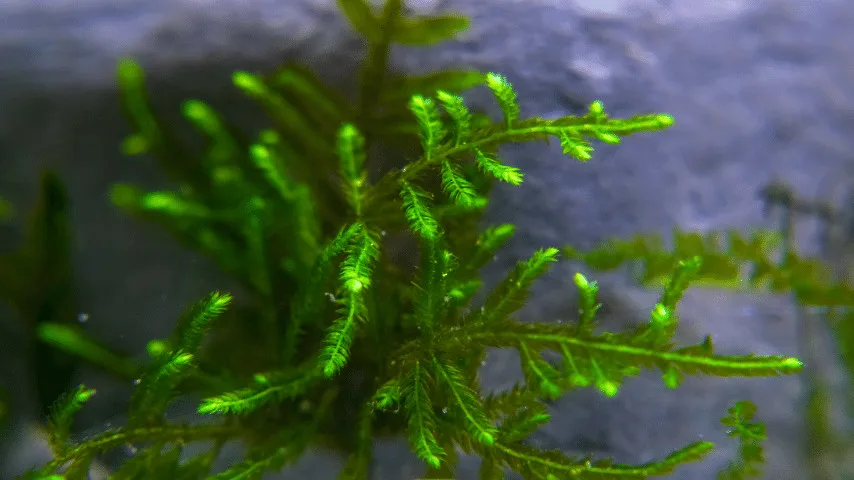
Christmas moss is an underwater ornamental plant mostly planted at the base of an aquarium to give a carpeted look.
It is not fast-growing and is named for its appearance, which resembles a Christmas tree due to its branches hanging down in a crisscrossing structure.
It also plays the role of a hiding place for baby guppies.
The binomial nomenclature of Christmas Moss includes:
- Scientific name: Vesicularia montagnei
- Family: Hypnaceae
- Temperature: 70-90°F (21-32°C)
- Soil: The moss does not require a certain type of substrate to grow in a tank because the plant can directly absorb nutrients from the water due to its shallow root structure.
- pH: Between 5.0 and 7.5
- Environment: Warm and humid environments.
- Humidity: 80% to 100%
4. Anacharis Elodea Densa
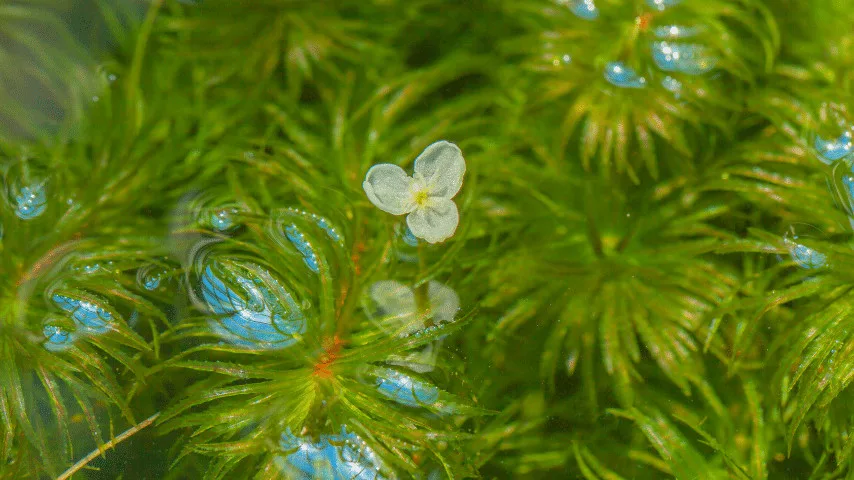
It is also known as the ‘Brazilian Taer Weed.’ It is mostly used as a background plant for aquariums because of its dark green stems and many leaves.
It makes the perfect shelter for the guppies to lay their eggs and hiding spaces for the baby guppies.
The binomial nomenclature of Ancharis Elodea includes:
- Scientific name: Egeria densa
- Family: Hydrocharitaceae
- Temperature: 72-78°F (22-25°C)
- Soil: They require 1 to 2 inches of the substrate so they do not float back to the surface. Aquarium gravel, muck, loam, or aquatic soil can be used.
- pH: 6.5 – 7.5
- Environment: They do best in moderate sunlight but can survive freezing temperatures.
- Humidity: 80% to 100%
5. Water Sprite
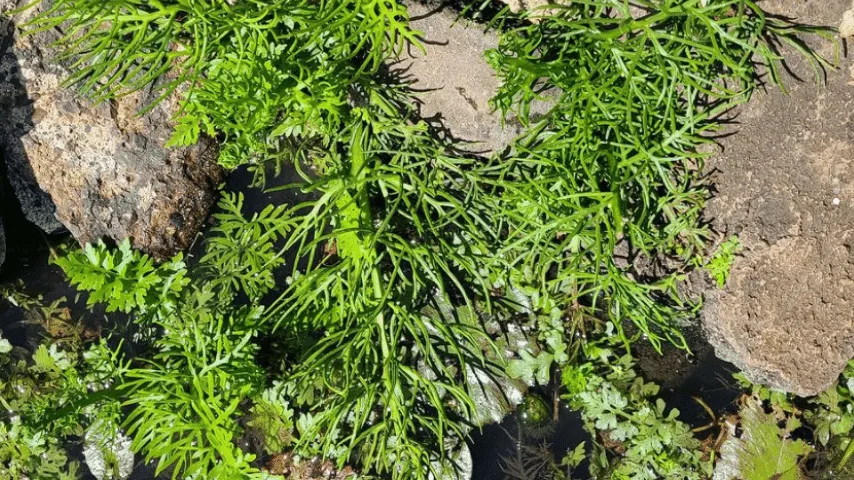
Water sprite is one of the most versatile, fast-growing, floating aquatic ferns known for its lush green appearance, low maintenance, and easy care.
Water Spites are fern-like with thin leaves that are light green. Cracks, tears, holes, and rips cannot be seen in the leaves of a healthy Water Sprite.
They also serve as a good hiding spot for baby guppies.
The binomial nomenclature of Water Sprite includes:
- Scientific name: Ceratopteris thalictroides
- Family: Pteridaceae
- Temperature: 68-80°F (20-27°C)
- Soil: They can be planted at the aquarium’s base using substrate and left floating in the water. Water sprites must be planted in approximately 2 to 3 inches of gravel to stabilize their roots.
- pH: 6.0-7.5
- Environment: It grows best in moderate to high light conditions but can survive low lights.
- Humidity: 80% to 100%
6. Water Wisteria
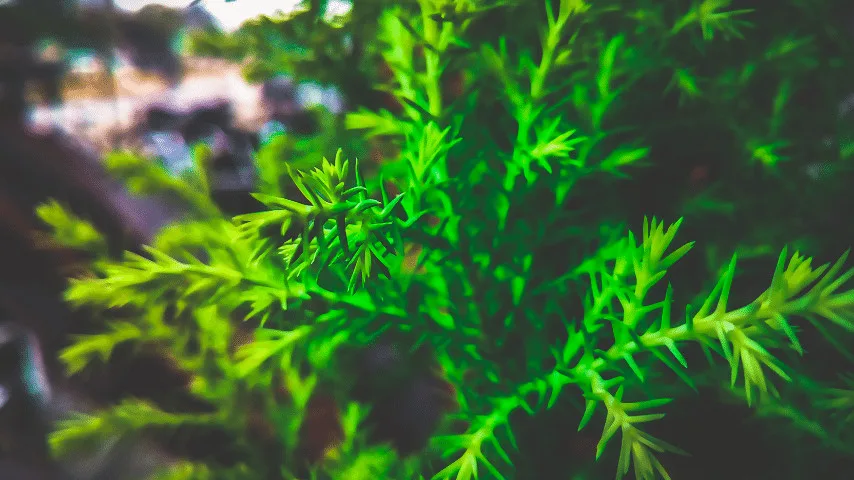
Water wisteria is a popular aquarium plant with lacy leaves, bright green color, and rapid growth.
It is a versatile plant and is easy to care for. Besides providing hiding spaces for the baby guppies like other plants, it also helps clean the water.
Moreover, It will be as a background or carpet according to preference.
The binomial nomenclature of Water Wisteria includes:
- Scientific name: Hygrophila difformis
- Family: Acanthaceae
- Temperature: 70-82°F (21-28°C)
- Soil: Sandy, nutrient-rich substrate
- pH: 6.5-7.5
- Environment: Water that is gentle to moderately hard should be used. The plant requires moderate to high sunlight.
- Humidity: 40% to 50%
7. Java Fern
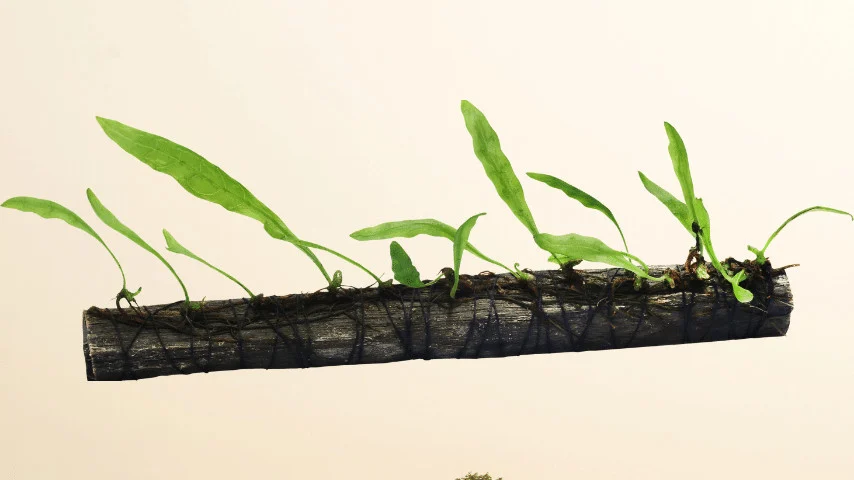
Java fern is an affordable and resilient plant with a leathery leaf texture and bright green color.
It may reach 14 inches in height. And is best for laying eggs for the guppies. It is a slow-growing plant used as a midground plant in aquariums.
The binomial nomenclature of Java Fern includes:
- Scientific name: Leptochilus pteropus
- Family: Polypodiaceae
- Temperature: 68–80°F (20–26°C)
- Soil: Doesn’t grow in soil or water. It can only grow in an aquarium if it is linked to driftwood or rocks.
- pH: 6.0 to 7.5
- Environment: Each gallon of water requires 1.5 watts of light. It usually thrives in low to moderate light because strong lighting can cause the plant to go brown instead of bright green.
- Humidity: 80% to 100%
8. Anubias Nana
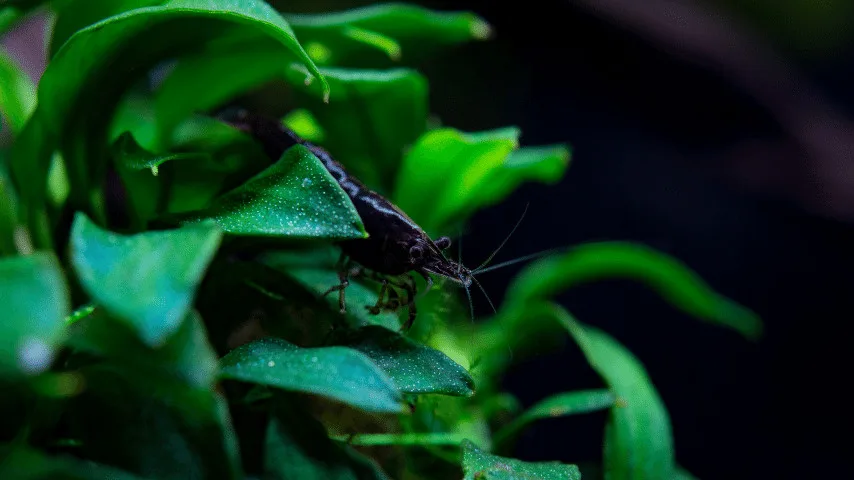
Anubias Nana is a short plant with broad, dark green leaves.
It’s an excellent plant that contributes to cleaning and oxygenating the tank water.
It’s a low-maintenance, slow-growing plant that provides baby guppies hiding places.
The binomial nomenclature of Anubias includes:
- Scientific name: Anubias barteri var. nana
- Family: Araceae
- Temperature: 72-82°F (22–28°C)
- Soil: As long as the rhizome is not buried, oil/aqua soil will suffice. They absorb nutrients through their roots well, just like most other plants.
- pH: 6.0-7.5
- Environment: It requires low to moderate lighting.
- Humidity: 70% to 100%
9. Guppy Grass
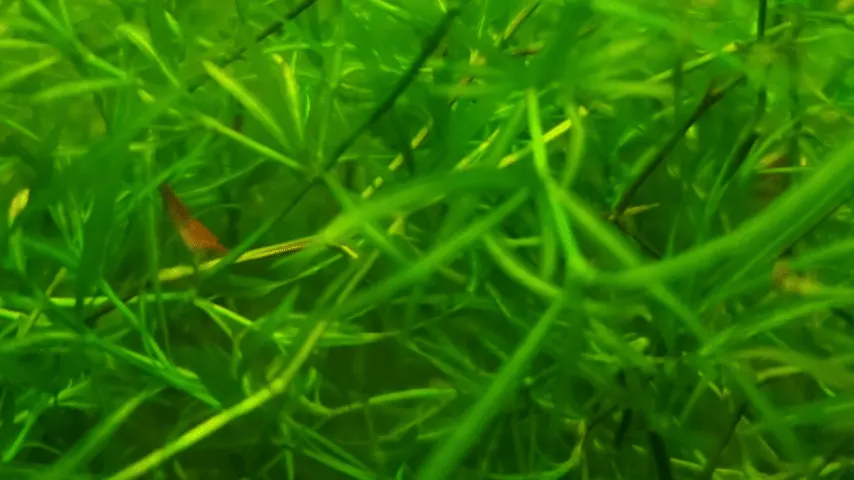
As the name suggests, this grass is best for guppies.
It helps remove heavy metals, toxins, ammonia, and nitrites from the water to keep it clean, produce oxygen, and prevent algae growth.
It may be planted or let float in the water. It also changes its leaf shape according to how it’s grown.
The binomial nomenclature of Guppy Grass includes:
- Scientific name: Najas guadalupensis
- Family: Hydrocharitaceae
- Temperature: 50 – 86°F (10–30°C)
- Soil does not require soil or fertilizers; however, liquid fertilizers can be used if the water lacks basic nutrients.
- pH: 6.0 to 7.0
- Environment: requires medium to low light. Exposure to high light can cause a reddish tint in its leaves.
- Humidity: 80% to 100%
10. Green Foxtail
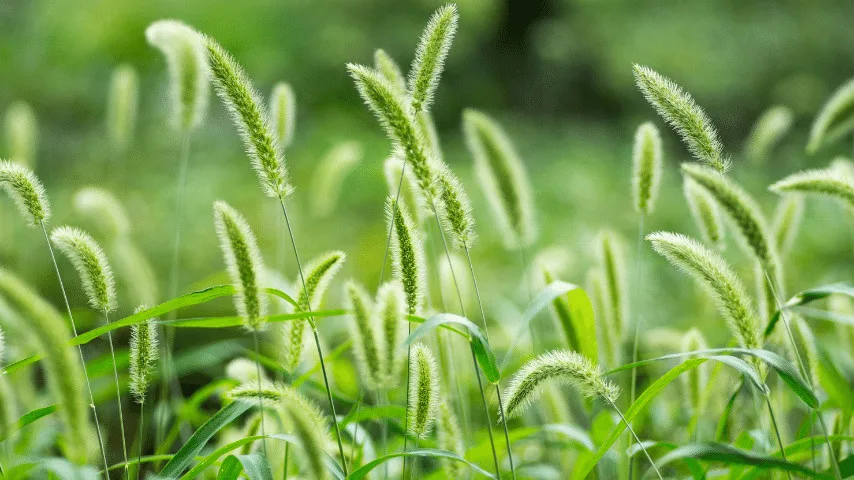
Green foxtail is a beautiful, hardy aquatic plant that adds to the beauty of an aquarium.
It grows in the foreground and gives a naturalistic touch to the aquarium. Its leaves are very soft and delicate with a feathery texture.
It helps enhance the water quality and is good for guppies for laying eggs and hiding.
The binomial nomenclature of Green Foxtail includes:
- Scientific name: Myriophyllum pinnatum
- Family: Haloragaceae
- Temperature: 72 – 82°F (22–28°C)
- Soil: Quality aquatic-safe soil is preferred as compared to sand. Excessive nutrients should be avoided if the water already has enough nutrients.
- pH: 5.0 – 7.0
- Environment: It requires moderate lighting and slightly tropical temperatures.
- Humidity: 60% to 100%
11. Chain Sword
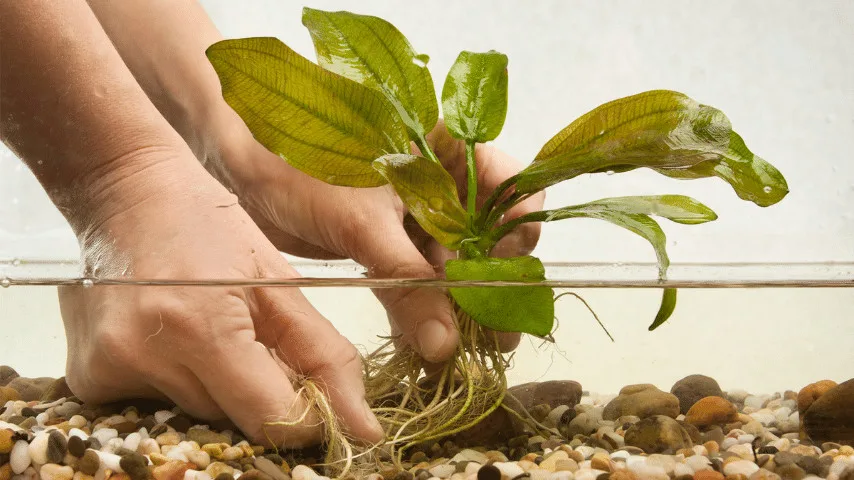
Chain sword, sometimes known as pygmy chain sword, is a grass-like plant that is one of the simplest to carpet.
It is a fast-growing plant and grows up to 4 inches tall.
The binomial nomenclature of Chain Sword includes:
- Scientific name: Echinodorus tenellus
- Family: Alismataceae
- Temperature: 68 – 84°F (20°C – 29°C)
- Soil: Pygmy chain sword grows best in fine gravel filled at least 2 inches for proper rooting. One of the ideal options is aquarium sand, which is nutrient-rich.
- pH: 6.2 – 7.5
- Environment: they are ideal for tropical and cold aquariums.
- Humidity: Between 55% and 80%
12. Hornwort
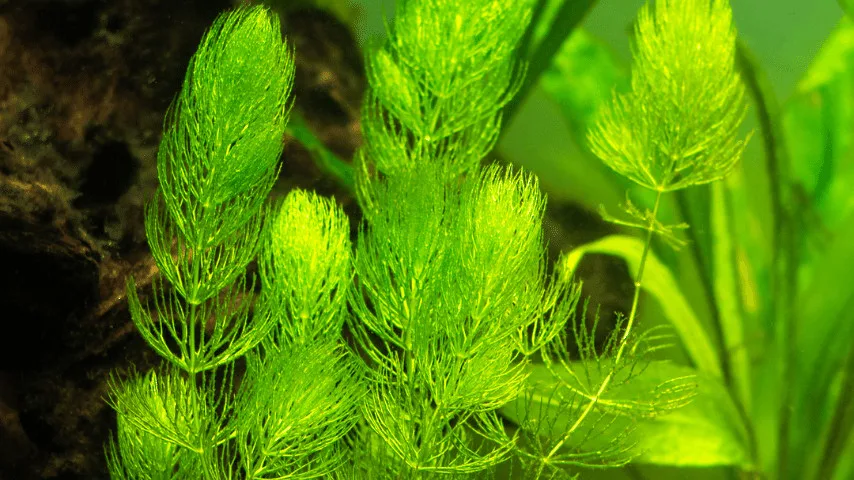
Hornwort is a fast-growing stem plant that can grow up to 10 feet.
It can withstand different kinds of water conditions and is a good hiding spot for baby guppies.
The binomial nomenclature of Hornwort includes:
- Scientific name: Ceratophyllum demersum
- Family: Ceratophyllaceae
- Temperature: 59-86°F (15°C – 30°C)
- Soil: Hornwort does not need substrate as it does not grow roots and floats in the water. However, the leaf-like projections on the plant will normally attach to gravel or sand and anchor the plant to the bottom of the tank.
- pH: 6.0 – 7.5
- Environment: tropical and warm temperate regions.
- Humidity: 70% to 100%
13. Duckweed
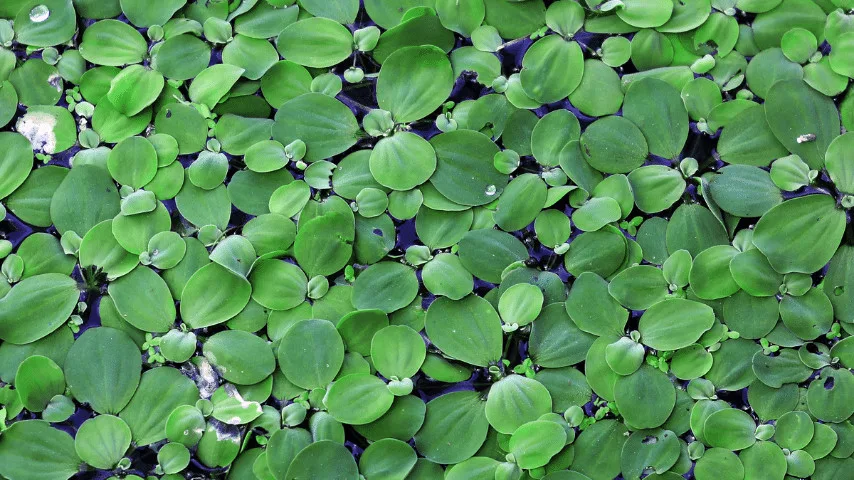
Duckweed purifies the water in your aquarium and gives a lot of hiding spots for guppy fry.
It is an excellent water purifier for aquariums. Guppy fry may hide in different kinds of places.
The binomial nomenclature of Duckweed includes:
- Scientific name: Lemnoideae
- Family: Araceae
- Temperature: 42.8 to 91.4° F (6°C – 33°C)
- Soil: It does not need substrate as it is a floating plant.
- pH: 5.0 – 9.0
- Environment: Can survive full sunlight as well as dense shade.
- Humidity: 60% to 100%
14. Red Root Floater
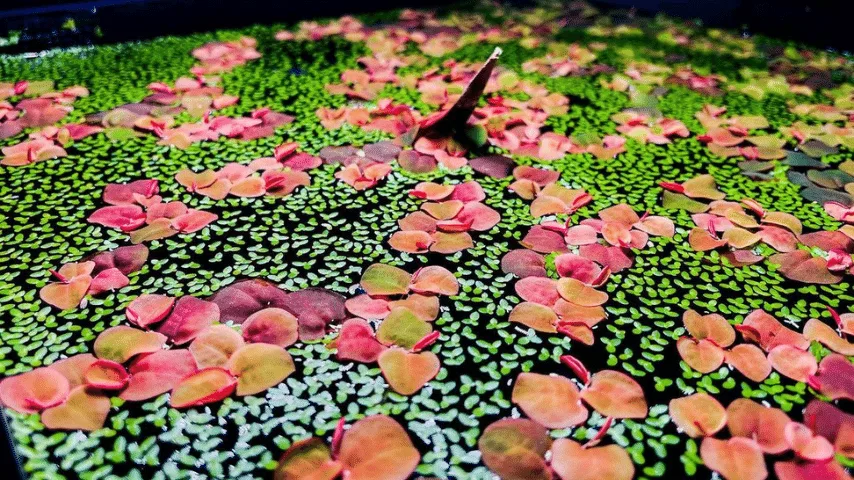
Red root floaters are small floating ferns that are fast-growing and can cover the whole surface of the water tank.
It provides shades that the guppies like and helps prevent algal growth.
The binomial nomenclature of Red Root Floater includes:
- Scientific name: Phyllanthus fluitans
- Family: Phyllanthaceae
- Temperature: 70° – 82° F (21°C – 28°C)
- Soil: They do not need substrate because they are floating plants, but they can benefit from iron supplements in water.
- pH: 6.5 – 7.5
- Environment: Can thrive in low to high lighting but requires water accordingly. They also need nutrient-rich water
- Humidity: 70% to 100%
15. Salvinia Natans
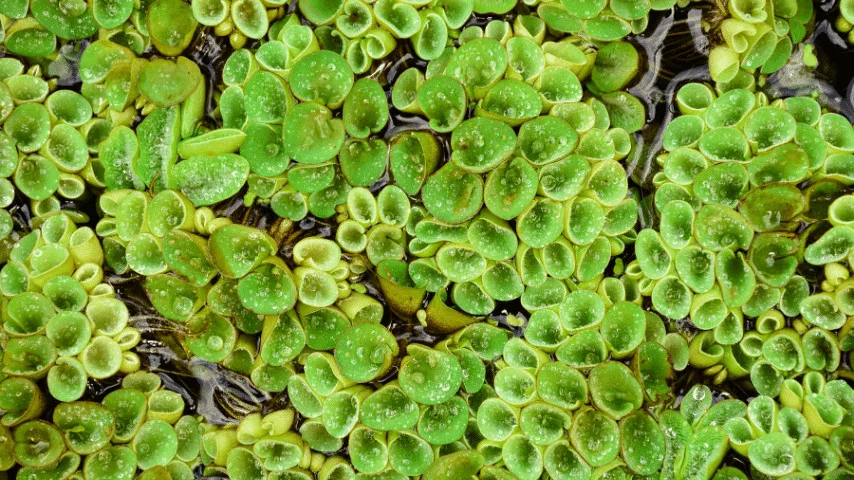
Salvinia natans is an annual floating aquatic fern that looks similar to moss.
Small leaves with tiny hairs make them water-resistant and help shade the aquarium to prevent algae.
They’re also utilized in open aquariums as aesthetic plants.
Thebinomial nomenclature of Salvinia Natans includes:
- Scientific name: Salvinia natans
- Family: Salviniaceae
- Temperature: 60° – 70° F (15.5 – 21.1°C)
- Soil: Do not require substrate as they are floating ferns.
- pH: 6.5 – 7.5
- Environment: They require heavy lighting and a well-lit tank. Prefers warm and humid locations.
- Humidity: 77% to 88%
16. Moss Balls
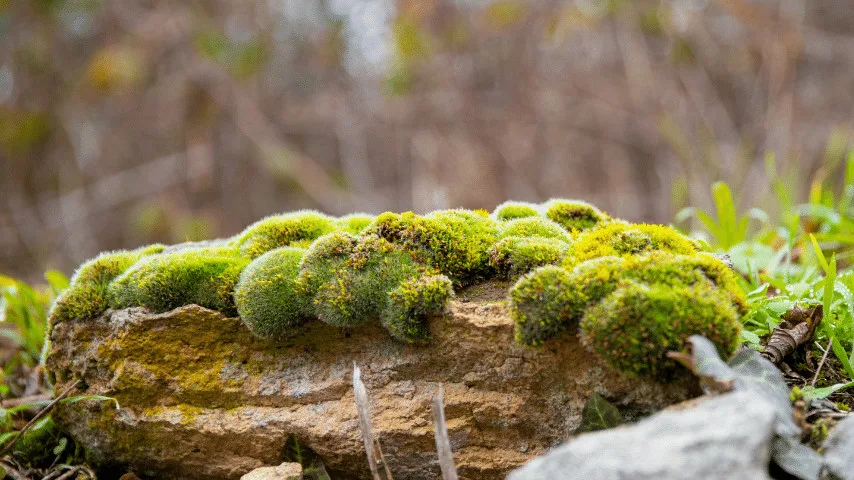
Moss balls are more like balls of algae with velvet-like structures and have little care requirements.
They cover the fry and are primarily used for cleaning the aquarium water.
The binomial nomenclature of Moss Balls includes:
- Scientific name: Aegagropila linnaei
- Family: Pithophoraceae
- Temperature: 72-78°F (22-25°C)
- Soil: the substrate is not needed.
- pH: 6.0-8.0
- Environment: grows best in cooler water.
- Humidity: 40% to 50%
17. Water Lettuce
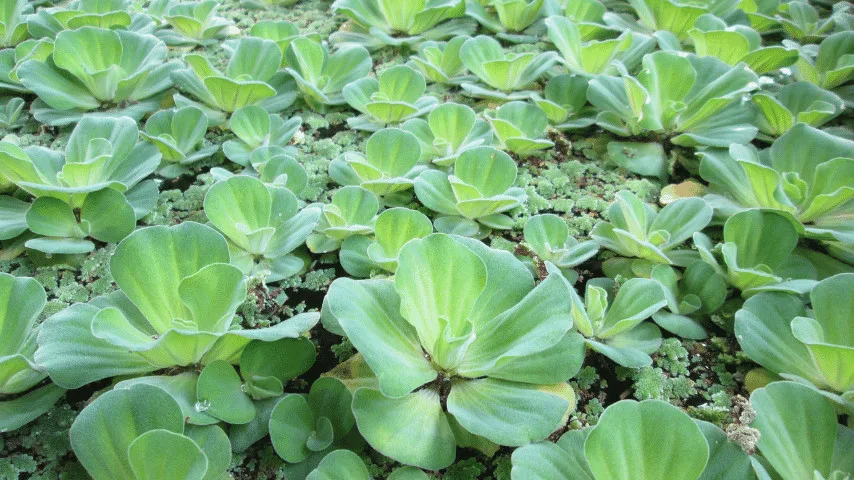
Water lettuce has giant leaves and long roots that help suck the nutrients from the water.
They provide shelter to the guppies, due to which most of the guppies tend to swim near the water lettuce.
The binomial nomenclature of Water Lettuce includes:
- Scientific name: Pistia stratiotes
- Family: Araceae
- Temperature: 72-86°F (22–30°C)
- Soil: no substrate is needed since it is a floating plant.
- pH: 6.5 – 7.5
- Environment: mostly occurs in temperate climates and cannot survive highly alkaline and extremely cold weather.
- Humidity: 70% and above.
18. Amazon Sword
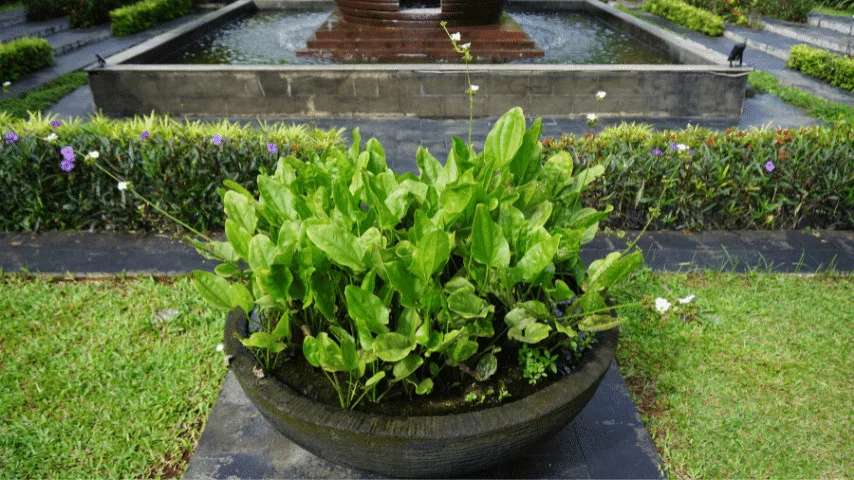
Amazon sword is an aquatic plant with lush green leaves and strong roots.
It can be used as a background plant for large aquariums and provide hiding spaces for the fry.
The binomial nomenclature of Amazon Sword includes:
- Scientific name: Echinodorus grisebachii
- Family: Alismataceae
- Temperature: between 72°F and 82°F. (22-28°C)
- Soil: loose substrate with small grain gravel or specialty planting substrate.
- pH: 6.5-7.5
- Environment: Requires 10 hours of bright light every day.
- Humidity: 70% and above.
19. Moneywort
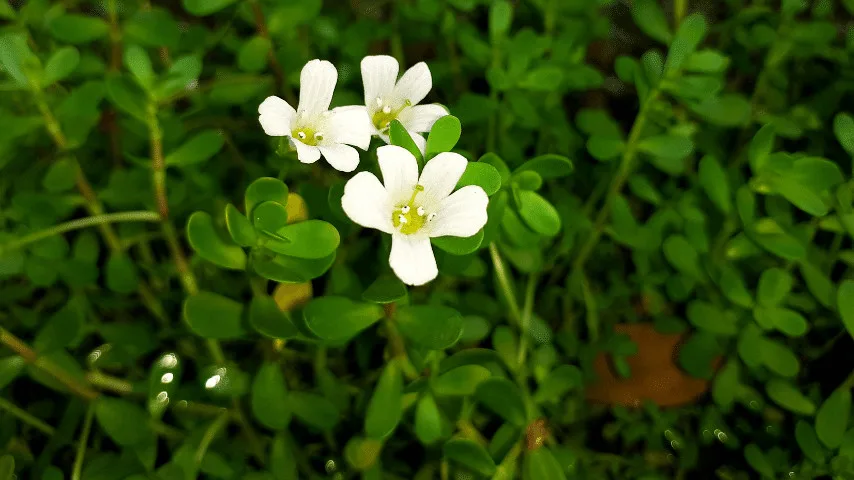
Moneywort is a slow-growing plant that may be employed in your aquarium’s mid-ground section.
It is a bright and light green creeping stem plant that can be seen growing along rocks or mud.
The binomial nomenclature of Moneywort includes:
- Scientific name: Bacopa monnieri
- Family: Plantaginaceae
- Temperature: 72-82° F (22-28°C.)
- Soil: It does not require a special substrate, however, aquarium dirt is preferred. This plant may also be grown in gravel or sand, although it will be difficult to plant due to its tendency to float.
- pH: 6.5-7.5
- Environment: requires 10 to 12 hours of light per day.
- Humidity: 65-80%
20. Cryptocoryne
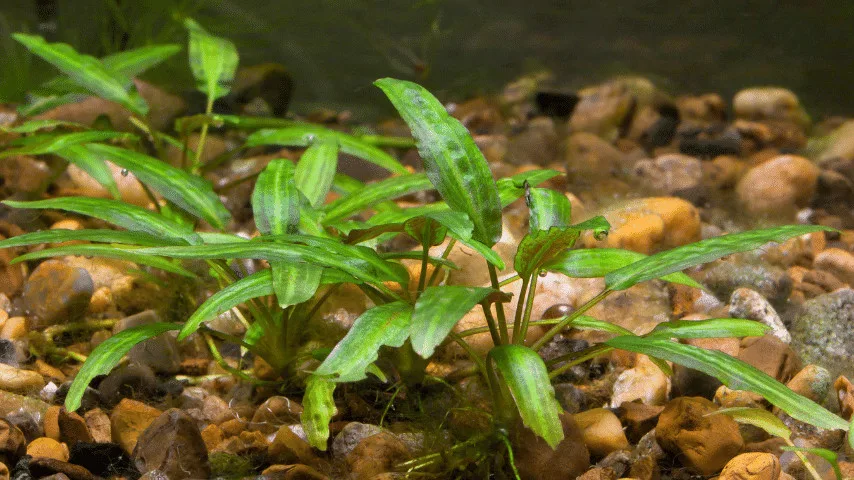
Cryptocoryne is an easy-to-grow aquarium plant that is available in various colors. These plants also provide hiding spaces for guppy fry.
The binomial nomenclature of Cryptocoryne includes:
- Scientific name: Cryptocoryne wendtii
- Family: Araceae
- Temperature: 68 and 82°F (68 – 28°C)
- Soil: These plants must be firmly planted in the aquarium’s substrate.
- pH: 6.8 – 7.2
- Environment: tropical regions and various lighting conditions.
- Humidity: 70-80%
These were the best plants for guppies. I hope with this list of plants, you will find your favorites for your guppy aquarium or pond.

